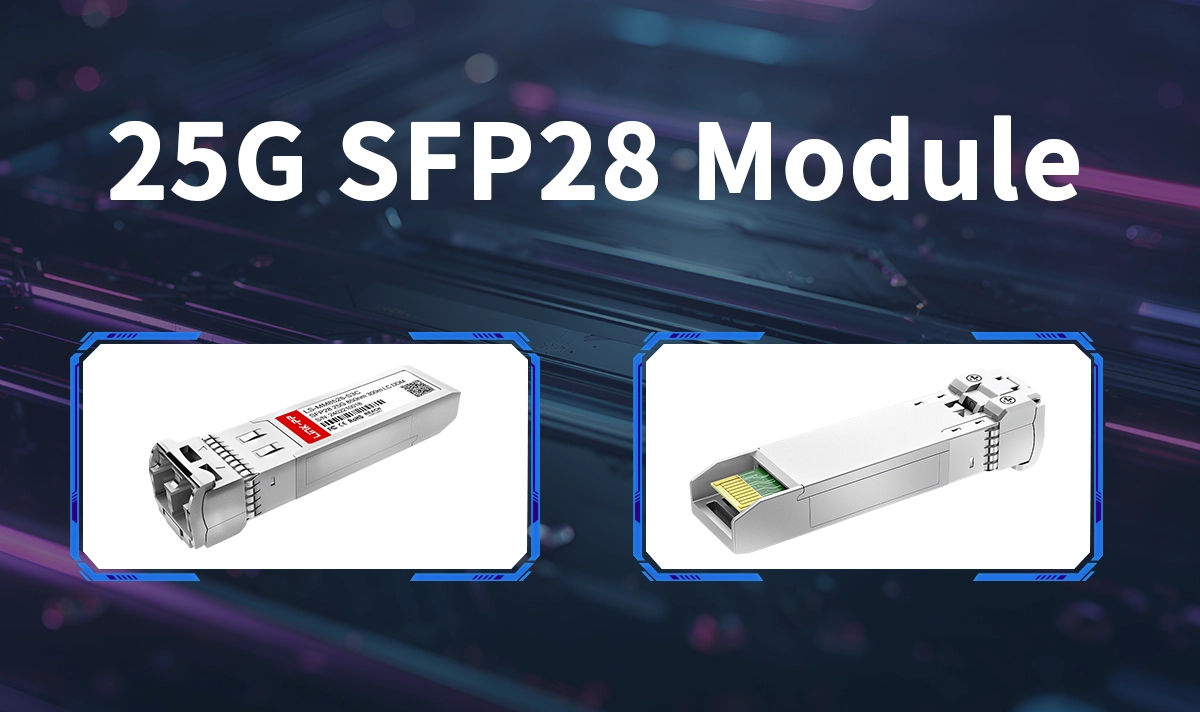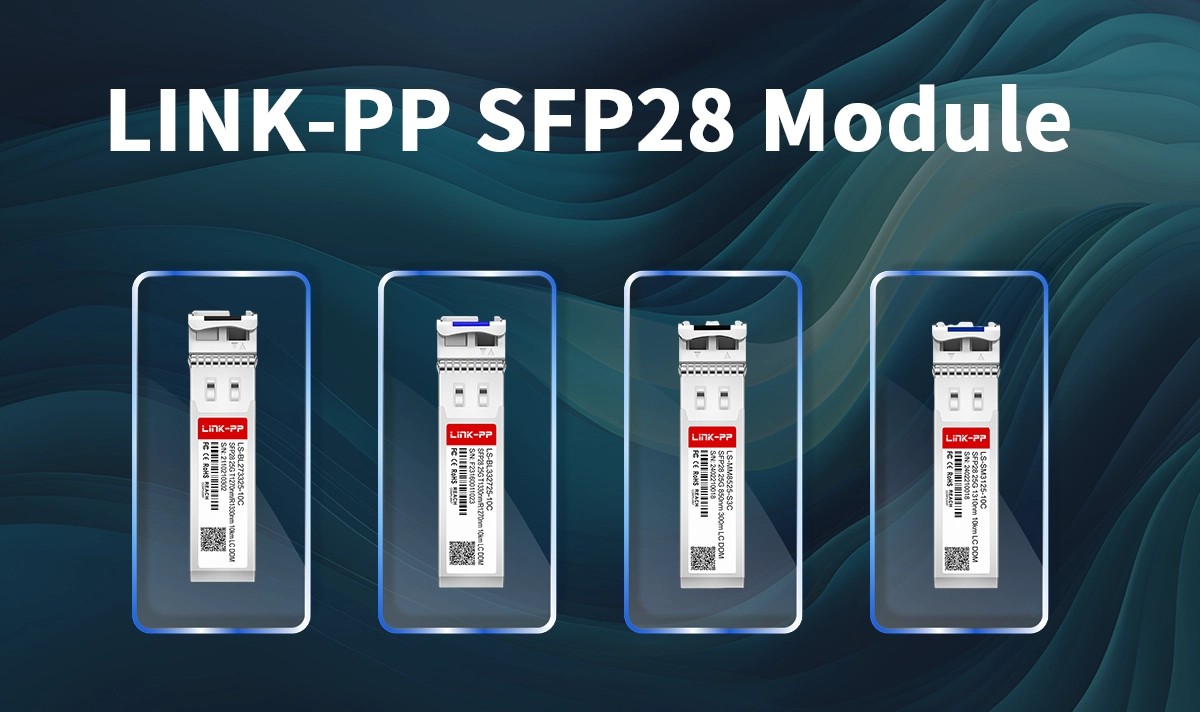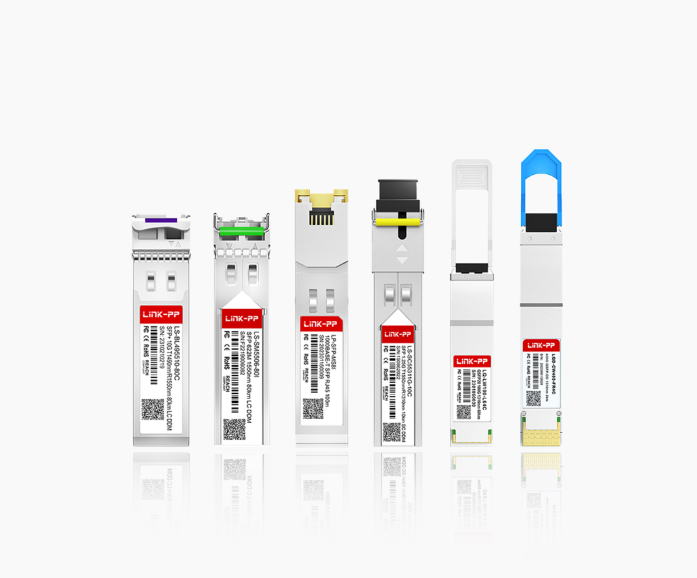
As network demands explode – driven by cloud computing, AI, 5G, and hyper-scale data centers – the limitations of 10 Gigabit Ethernet (10GbE) become apparent, while 100 Gigabit Ethernet (100GbE) can be overkill or too costly for many applications. Enter the SFP28 transceiver, the crucial bridge technology delivering cost-effective, high-density 25 Gigabit per second (25G) connectivity. But what is SFP28 exactly, and why has it become a cornerstone of modern network upgrades? This guide dives deep into SFP28 technology, its various types, advantages, and how to leverage it effectively.
▻ Key Takeaways
SFP28 modules send data very fast, up to 25Gbps. This helps networks move more data quickly and easily.
They fit in the same small slots as older SFP+ modules. This makes it easy to upgrade without buying all new equipment.
SFP28 works with older devices, so you can upgrade slowly. This helps save money over time.
These modules use less power and make less heat. This lowers energy bills and helps the network work better.
SFP28 can connect over long distances and is hot-swappable. This keeps networks working well during changes.
▻ What is SFP28? Defining the Form Factor
SFP28 stands for Small Form-factor Pluggable 28 Gigabit. It's the third generation of the ubiquitous SFP (Small Form-factor Pluggable) module family, succeeding SFP (1G) and SFP+ (10G). The "28" signifies its maximum nominal data rate capability of 28 Gigabits per second (Gbps), though it's primarily used for 25 Gigabit Ethernet (25GbE) and single-lane 32G Fibre Channel applications.
Physical Compatibility: SFP28 modules share the identical physical form factor as SFP and SFP+ modules. This backward compatibility is a massive advantage, allowing network operators to upgrade existing SFP+ switch ports to 25G speeds simply by swapping transceivers and upgrading the switch software/hardware where needed, protecting infrastructure investments.
Electrical Interface: While physically similar, SFP28 utilizes a higher-speed 28 Gbps electrical interface compared to SFP+'s 10Gbps. This electrical signaling upgrade is key to delivering the 25G data rate.
▻ SFP28 vs. SFP+: Why Upgrade to 25G?
Understanding the SFP28 vs SFP+ comparison is crucial for justifying the upgrade. Here's a breakdown:
Feature | SFP+ (10G) | SFP28 (25G) | Advantage of SFP28 |
|---|---|---|---|
Data Rate | 10Gbps | 25Gbps | 2.5x the bandwidth |
Electrical IF | 10Gbps NRZ | 28Gbps NRZ | Higher speed signaling |
Power Consumption | ~1W (Typical) | ~1W - 1.5W (Typical) | Highly efficient per Gbps |
Form Factor | SFP+ | Identical to SFP+ | Seamless port upgrade |
Primary Use | 10GbE, 8G/16G Fibre Channel | 25GbE, 32G Fibre Channel | Next-gen access/aggregation, storage |
Cost per Gbps | Higher | Significantly Lower | Better ROI, denser bandwidth |
Bandwidth Density: Delivers 2.5x the bandwidth of SFP+ in the same physical port space, dramatically increasing switch capacity without increasing footprint. This is vital for data center spine-leaf architecture and 5G fronthaul/midhaul.
Cost Efficiency: Provides a significantly lower cost per gigabit compared to SFP+ for 10G and often a more economical entry point than QSFP28 for 100G (using 4x SFP28 lanes). 25G DAC cables and 25G AOC cables offer very cost-effective short-reach solutions.
Power Efficiency: While consuming slightly more absolute power than SFP+, SFP28 is vastly more power efficient per gigabit transmitted, a critical factor in large-scale deployments.
Path to 100G/400G: SFP28 is the fundamental building block for 100G (using QSFP28 with 4x25G lanes) and even 400G (using QSFP-DD/OSFP with 8x50G PAM4 lanes derived from 25G NRZ technology).
▻ Exploring SFP28 Transceiver Types: Matching Reach & Media
Choosing the right SFP28 module type depends entirely on the required transmission distance and the fiber optic cable available (multimode or singlemode). Here are the primary categories:
SFP28 SR (Short Reach):
LINK-PP Model: LS-MM8525-S1C
Technology: 850nm VCSEL laser.
Fiber Type: Multimode Fiber (MMF - OM3/OM4/OM5).
Reach: Up to 70m on OM3, 100m on OM4, 150m on OM5. Standardized as 100m on OM4.
Application: Top-of-Rack (ToR) switching, intra-rack connections, short data center links. Uses cost-effective LC duplex MMF patch cables.
SFP28 LR (Long Reach):
LINK-PP Model: LS-SM3125-10C
Technology: 1310nm DFB laser.
Fiber Type: Single mode Fiber (SMF - OS2).
Reach: Up to 10 kilometers (km).
Application: Common for data center aggregation, enterprise core/distribution, longer campus links, telecom access. The workhorse for 25G singlemode fiber deployments. LINK-PP's 25GBASE-LR Module is a prime example of a reliable, MSA-compliant LR module.
SFP28 ER (Extended Reach):
LINK-PP Model: LS-SM3125-40C
Technology: 1550nm DFB laser, often with APD receiver.
Fiber Type: Single-mode Fiber (SMF - OS2).
Reach: Up to 40 kilometers (km).
Application: Metro network edges, longer campus/enterprise backbone links, scenarios requiring beyond LR reach but not full ZR. LINK-PP 25GBASE-ER Module delivers this extended performance.
SFP28 ESR (Extended Short Reach):
LINK-PP Model: LS-MM8525-S3C
Technology: 850nm VCSEL laser, PIN photodiodes.
Fiber Type: Multi-mode Fiber (MMF - OM4).
Reach: Up to 300m on OM4 cable.
Application: 25GBASE-SR Ethernet links.
SFP28 CWDM & DWDM (Wavelength Division Multiplexing):
Technology: Uses specific CWDM (18 wavelengths from 1270nm to 1610nm) or DWDM (C-band or L-band, densely spaced) lasers.
Fiber Type: Single mode Fiber (SMF - OS2).
Reach: Typically LR (10km), ER (40km) based on the underlying optics.
Application: Maximizing fiber capacity by carrying multiple 25G signals on different wavelengths over a single fiber pair. Essential for service provider networks and large enterprises needing scalable bandwidth. LINK-PP optical transceivers enable efficient 25G DWDM and 25G CWDM solutions.
SFP28 DAC (Direct Attach Copper) & AOC (Active Optical Cable):
Technology: DAC uses passive copper twinax cables with integrated connectors. AOC uses active electrical-optical conversion within the connectors with fiber in between.
Reach: DAC: Typically 1-5m (passive), up to 7-15m (active). AOC: Typically 1m to 30m+.
Application: Ultra-short connections within racks or between adjacent racks. DAC is the most cost-effective. AOC offers lighter weight, flexibility, and longer reach than passive DAC. Essential for high-density switch deployments.
▻ Key Applications Driving SFP28 Adoption
Data Center Spine-Leaf Architecture: SFP28 is the de facto standard for 25G server access (Leaf to Server) and often for the Leaf-to-Spine uplinks (using 4x SFP28 = 100G).
5G Mobile Networks: Critical for fronthaul (DU to RU) and midhaul (CU to DU) transport, demanding low latency and high bandwidth.
Enterprise Networks: Upgrading core and distribution layers beyond 10G, supporting high-speed Wi-Fi 6/6E/7 access points and backbone links.
High-Performance Computing (HPC) & Storage Area Networks (SAN): Providing low-latency, high-bandwidth interconnects for clusters and storage (32G Fibre Channel).
Broadband Network Gateways (BNGs) & Cable Modem Termination Systems (CMTS): Handling increasing subscriber bandwidth demands.
▻ Choosing the Right SFP28 Transceiver: Key Considerations
Selecting the SFP28 25G transceiver involves more than just reach:
Required Distance & Fiber Type: Match the module (SR/LR/ER/WDM) to your fiber plant (MMF/SMF) and distance.
Compatibility: Ensure MSA (Multi-Source Agreement) compliance and compatibility with your specific switch/router brand and model. Third-party optical transceivers from reputable manufacturers like LINK-PP offer significant cost savings while guaranteeing compatibility and performance. (Keywords: SFP28 compatibility, MSA compliant SFP28).
Performance & Reliability: Look for rigorous testing (DDM/DOM monitoring, BER testing) and quality components. LINK-PP optical modules undergo extensive validation.
Cost: Balance upfront cost with TCO (Total Cost of Ownership), including power consumption and reliability. Avoid risky no-name brands.
WDM Needs: If fiber is scarce, CWDM or DWDM SFP28s are essential for fiber capacity optimization.

LINK-PP: Your Partner for High-Performance SFP28 Solutions
As a leading innovator in optical networking, LINK-PP offers a comprehensive portfolio of high-quality, reliable, and cost-effective SFP28 optical transceivers. Our modules, including 25GBASE-SR, 25GBASE-LR, 25GBASE-ER, 25GBASE-ESR, and a wide range of 25G CWDM/DWDM variants, are rigorously tested to meet or exceed industry standards (IEEE, MSA) and ensure seamless compatibility with major OEM platforms. We provide best-in-class 25G connectivity solutions backed by expert technical support.
▻ Conclusion: SFP28 - The Smart Choice for 25G Connectivity
SFP28 has firmly established itself as the dominant solution for 25G and 32G Fibre Channel connectivity. Its combination of backward compatibility with SFP+ infrastructure, superior bandwidth density, excellent power efficiency, and compelling cost per gigabit makes it indispensable for modern data centers, 5G networks, and evolving enterprise backbones. By understanding the different SFP28 types – from SR and LR to ER, CWDM, and DWDM – and their specific applications, network planners can make informed decisions to build scalable, high-performance networks.
Ready to Optimize Your Network with 25G?
Upgrade your infrastructure efficiently and cost-effectively with LINK-PP's extensive range of premium SFP28 transceivers. Explore our SFP28 solutions today and discover how our reliable optical modules can enhance your network's speed, capacity, and ROI. Contact our technical sales team for personalized advice on selecting the perfect 25G transceiver for your specific needs!
▻ See Also
SFP-10G-SR vs SFP-10G-LR: Key Difference Explained
SMF vs MMF Cable: A Complete Comparison Guide
Understanding MSA (Multi-Source Agreement) in Optical Transceivers




